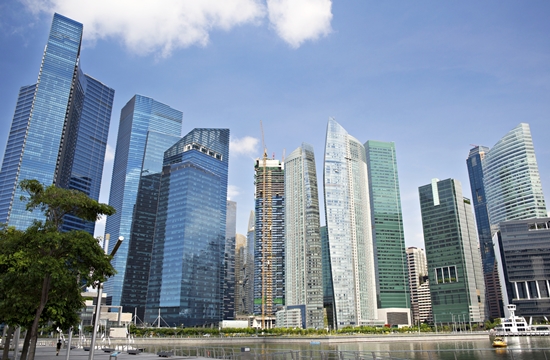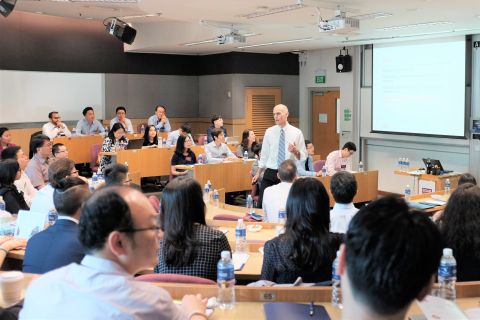
By Juliana Chan
SMU Office of Research & Tech Transfer – The impressive skylines of big cities are dotted with hulking skyscrapers; in the day, these buildings hum with activity, and at night, they give off an eerie, iridescent hue. The individuals who work in these towers, and the companies based there, all have unique stories to tell.
Taking a magnifying glass to these stories is all in a day’s work for the world-leading experts attending the inaugural 2017 SMU Conference on Urban and Regional Economics, held from 18-19 December 2017 at the Singapore Management University (SMU) School of Economics.
Organised by SMU School of Economics Professors Hsu Wen-Tai and Li Jing, the conference focused on a variety of urban-related topics, ranging from housing to transportation in cities. The event featured keynote lectures from Professors Gilles Duranton of the University of Pennsylvania, Stuart Rosenthal of Syracuse University, Esteban Rossi-Hansberg of Princeton University, and Yves Zenou of Monash University.
The power of proximity
“Cites are expensive places, so why would you do business in such an environment?” asked Professor Rosenthal, who gave the first keynote lecture of the conference. “It must be the case that businesses get back something in return, or why put up with the high cost of space and labour?”
In his lecture, titled ‘Building Specialisation, Anchor Tenants and Agglomeration Economies’, Professor Rosenthal offered a new perspective on the productivity of cities – the close proximity of tenants in tall, commercial buildings provides a boost to their productivity.
“Previous work on agglomeration economies has focused on horizontal patterns of sorting and productivity, using political boundaries and distance-based measures... That has been revealing but misses patterns at the building level. We’ve been thinking of spaces in a vertical fashion… by focusing on which building you are located in,” he explained.
To examine the hypothesis that productivity spillovers within industries may encourage companies to group together at the building level, Professor Rosenthal decided to look at Manhattan, New York City, where he noticed that the grouping of companies in the manufacturing, finance, insurance and real estate sectors in certain areas was not random.
By comparing the actual composition of industries in 419 buildings against 100 randomised samples, Professor Rosenthal and co-authors (Professors Crocker Liu and William Strange) showed that employment within 0.3 miles of the New York Stock Exchange tended to be unusually specialised at the building level. This was especially true for the financial sector but was also evident for retail, advertising, law and manufacturing. The researchers found a similar pattern for the 622 buildings within 0.3 miles of Grand Central Station, where advertising was the most highly concentrated industry.
What Professor Rosenthal proposes to be in play here is something called ‘agglomeration economies’, where companies located in close proximity benefit from shared skilled labour, intermediate inputs and knowledge, leading to productivity spillovers.
Why buildings need anchors
Proximity can also affect a common experience that many people enjoy: shopping. Think of the last time you made a trip to the mall to buy a new bag, only to come out later with a haircut, a cup of coffee, and – wait for it – even a gym membership.
“Most shopping malls have one or two anchor tenants – ‘big-box’ department stores – and lots and lots of small stores,” Professor Rosenthal said. “These anchor tenants typically enjoy rental discounts because there’s a perception in the shopping mall industry that they draw customers in and provide spillovers; smaller companies are then eager to move into the mall and are willing to pay higher rates per square foot than anchor tenants.”
Professor Rosenthal noted that anchor tenants are also important outside of retail. Large office buildings, for example, may have an anchor tenant that is an advertising agency or a law firm. In these sorts of buildings, anchor tenants generate productivity spillovers that attract smaller office companies to the building. If a commercial anchor is in the adjacent building, however, its attraction is greatly reduced.
These and other patterns show that productivity spillovers in the office sector occur within individual buildings, as well as within broader neighbourhoods, said Professor Rosenthal. Companies in search of a new office lease may thus want to take a close look at the building’s tenant mix in addition to the tenants of nearby buildings.
Transport’s butterfly effect
For the fourth consecutive year in 2017, the Economics Intelligence Unit ranked Singapore as the most expensive city for expatriates to live in, shared Ms Huang Naqun of Nanjing Audit University, who discussed the hot-button issue of Singapore’s car ownership system in a breakout session later in the day.
Titled 'The Impact of the Cost of Car Ownership on House Price Gradient in Singapore', Ms Huang’s study used data from a unique feature of Singapore’s car registration process—the certificate of entitlement (COE), which is obtained by prospective car owners through an open-bidding process.
Using a closed monocentric city model, Ms Huang showed that when COE prices increase, private non-landed properties close to the central business district are transacted at higher prices, suggesting that people were eschewing longer commutes in favour of living closer to their place of work.
Another speaker to touch on the impact of transportation on society was Professor Liao Wen-Chi of the National University of Singapore, whose presentation was titled 'The Butterfly Effect of Transport Network Connectivity and Welfare Implication'.
Professor Liao focused on stage one of the Downtown Line, a six-station mass rapid transit line covering a relatively short distance of 4.3 kilometres. Based on publicly available data on the resale prices of Housing and Development Board (HDB) flats from the period of January 2013 to January 2015, his research team showed that the opening of stage one of the Downtown Line led to an increase in the resale prices of nearby HDB flats.
Calling it a “butterfly effect”, he explained how the six stations led to benefits such as an aggregate increase in housing prices in the area, as well as improved transport connectivity.
“From our cost-benefit analysis, we find there to be about a S$2 billion benefit, outweighing the S$1.4 billion construction cost, or 0.4 percent of Singapore’s gross domestic product in 2013,” Professor Liao said.
Back to Research@SMU Issue 50
See More News
Want to see more of SMU Research?
Sign up for Research@SMU e-newslettter to know more about our research and research-related events!
If you would like to remove yourself from all our mailing list, please visit https://eservices.smu.edu.sg/internet/DNC/Default.aspx

